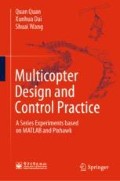Abstract
This chapter introduces the composition of the experimental platform released with this book and provides a thorough explanation of the role of each platform component. Examples with detailed experimental procedure are also presented in this chapter to familiarize readers with the basic functions and usage of the offered software and hardware, thereby laying a foundation for subsequent experiments to improve the learning efficiency.
Access this chapter
Tax calculation will be finalised at checkout
Purchases are for personal use only
Notes
- 1.
- 2.
corresponding to the circuit diagram version Pixhawk 2.4.6; for more details, please visit this website: https://docs.px4.io/master/en/flight_controller/pixhawk.html.
- 3.
In addition to supporting the PX4 autopilot software used in this book, the Pixhawk series autopilots also support Ardupilot open-source autopilot software; see: http://ardupilot.org/dev/index.html.
- 4.
In a real autopilot system, these signals should be obtained from the modules related to state estimation (e.g., raw sensor data, Kalman filter, and complementary filter). For simplicity, in the controller design during the SIL simulation the true values of the multicopter model can be used first.
- 5.
A value within the range from 1000 to 2000 corresponds to a higher level duration (in microseconds) of PWM signals. Given that the period of an RC PWM signal is usually 20 ms (50 Hz), the duty ratio of the PWM signal measured by a multimeter usually ranges from 0.05 to 0.1 instead of from 0 to 1.
- 6.
- 7.
- 8.
- 9.
Higher Pixhawk hardware (e.g., Pixhawk 2/3/4/5) starts to discard LED module, so an external I2C LED module is required to observe the lighting effect.
Author information
Authors and Affiliations
Corresponding author
Rights and permissions
Copyright information
© 2020 Publishing House of Electronics Industry
About this chapter
Cite this chapter
Quan, Q., Dai, X., Wang, S. (2020). Experimental Platform Usage. In: Multicopter Design and Control Practice. Springer, Singapore. https://doi.org/10.1007/978-981-15-3138-5_3
Download citation
DOI: https://doi.org/10.1007/978-981-15-3138-5_3
Published:
Publisher Name: Springer, Singapore
Print ISBN: 978-981-15-3137-8
Online ISBN: 978-981-15-3138-5
eBook Packages: Intelligent Technologies and RoboticsIntelligent Technologies and Robotics (R0)

